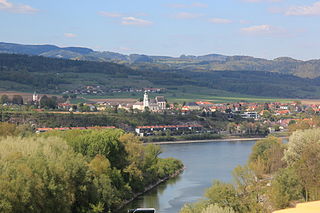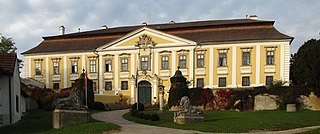
Lower Austria is one of the nine states of Austria, located in the northeastern corner of the country. Major cities are Amstetten, Krems an der Donau, Wiener Neustadt and Sankt Pölten, which has been the capital of Lower Austria since 1986, replacing Vienna, which became a separate state in 1921. With a land area of 19,186 km2 (7,408 sq mi) and a population of 1.7 million people, Lower Austria is the largest and second-most-populous state in Austria.

Krems an der Donau is a town with 25,271 inhabitants end 2022 in Austria, in the federal state of Lower Austria. It is the fifth-largest city of Lower Austria and is approximately 70 kilometres west of Vienna. Krems is a city with its own statute, and therefore it is both a municipality and a district.

Bezirk Melk is a district of the state of Lower Austria in Austria.

The Battle of Dürenstein or the Battle of Krems, on 11 November 1805, was an engagement in the Napoleonic Wars during the War of the Third Coalition. Dürenstein, Austria, is located in the Wachau valley, on the river Danube, 73 kilometers (45 mi) upstream from Vienna, Austria. The river makes a crescent-shaped curve between Dürnstein and nearby Krems an der Donau, and the battle was fought in the flood plain between the river and the mountains.

Bezirk Rohrbach is a district in the state of Upper Austria in Austria.
Bezirk Tulln is a district of the state of Lower Austria in Austria.

The Kamp is a 168-kilometre-long (104 mi) river in northern Austria, left tributary of the Danube. Its drainage basin is 2,177 km2 (841 sq mi).

The 2009 European floods were a series of natural disasters that took place in June 2009 in Central Europe. Austria, the Czech Republic, Germany, Hungary, Poland, Romania, Serbia, Slovakia and Turkey were all affected. The heavy rains caused overflowing of the rivers Oder, Vistula, Elbe and Danube. At least 12 people were killed in the Czech Republic and one in Poland.

Rosenburg is a castle in the municipality Rosenburg-Mold, Lower Austria, Austria. Rosenburg is on a cliff above the valley of the River Kamp at an elevation of 345 metres (1,132 ft) above sea level. It is one of Austria's most visited Renaissance castles. It is situated in the middle of a nature reserve - the Naturpark Kamptal - which adds to its appeal. There are various castles and fortifications in Austria and Germany that bear the name "Rosenburg", but if people use the term without further specifications, it may be understood that they refer to this site in Lower Austria. The well-known Austrian folk song "Es liegt ein Schloss in Österreich" is often assumed to refer to the Rosenburg.

Schloss Gobelsburg is a winery and castle in the Kamptal wine growing region in Lower Austria, some 80 kilometers to the north west of Vienna. The estate produces both red and white wines. Wine production on the estate dates to 1171; it is the oldest winery in the Danube region. The structure is a listed building.

The Wachau is an Austrian valley with a picturesque landscape formed by the Danube river. It is one of the most prominent tourist destinations of Lower Austria, located midway between the towns of Melk and Krems that also attracts "connoisseurs and epicureans" for its high-quality wines. It is 36 kilometres (22 mi) in length and was already settled in prehistoric times. A well-known place and tourist attraction is Dürnstein, where King Richard I of England was held captive by Leopold V, Duke of Austria. The architectural elegance of its ancient monasteries, castles and ruins combined with the urban architecture of its towns and villages, and the cultivation of vines as an important agricultural produce are the dominant features of the valley.

Wachau is one of Austria's most established and notable wine regions, specializing in dry wines made from Riesling and Grüner Veltliner. Located in Lower Austria along the Danube, west of Vienna and Krems an der Donau, it is one of the westernmost wine producing regions in Austria with only a few scattered plantings in Tyrol being further west. While most of Austria follows a wine classification systems based on ripeness and harvest must weight that parallels the German wine classification system, Wachau wines have a unique classification system. The three classification levels for Wachau wine include Steinfeder for wines up to 11.5% alcohol level, Federspiel for wines between 11.5–12.5% and Smaragd that must have a minimum of 12.5% alcohol level. Despite its renown, the Wachau is a small wine region that usually accounts for only around 3% of Austria's wine production.

The earliest Austrian walled towns started to appear in the late 11th century to the early 13th century. Their establishment was closely connected with the development of Austria as a march of the Holy Roman Empire and in particular by the Hohenstaufen emperors and their Marcher Lords, the Babenbergs. In present-day Austria, there are 106 towns or cities that were walled. The walls of Radstadt, Freiburg, Hainburg and Drosendorf survive almost intact, and Austria has some of the most impressive walled towns in Europe.

Rudolf Redlinghofer was an Austrian conscientious objector and victim of the Nazi regime. The Republic of Austria reversed his sentence 58 years after his execution, and Rudolf Redlinghofer became one of the first victims of the regime to be rehabilitated in Austria.

Schloss Grafenegg is a castle in Grafenegg, Lower Austria, Austria. Together with Burg Kreuzenstein and Schloss Anif near Salzburg, it is considered to be an outstanding example of romantic historical architecture in Austria.















